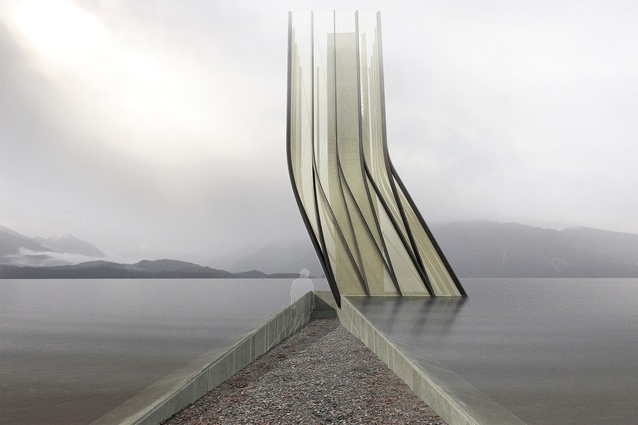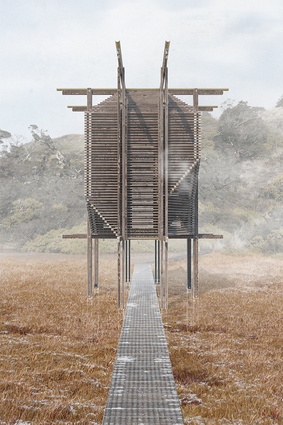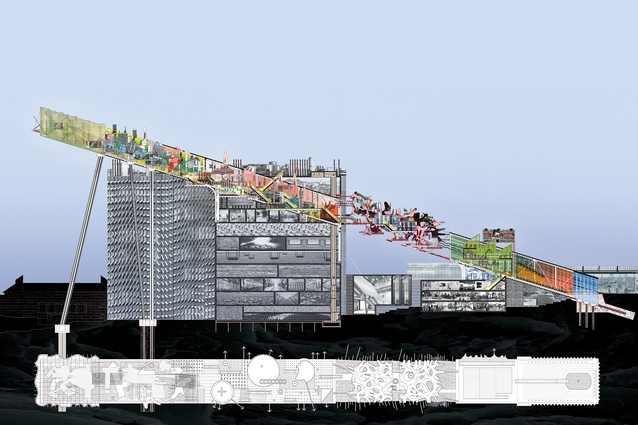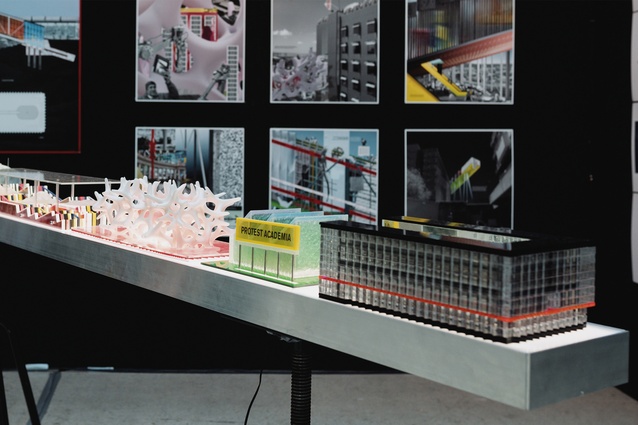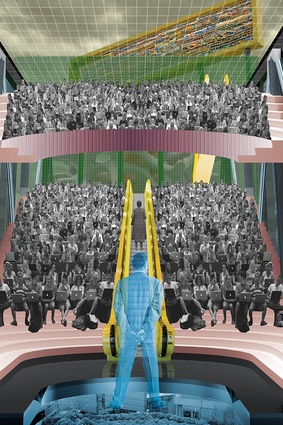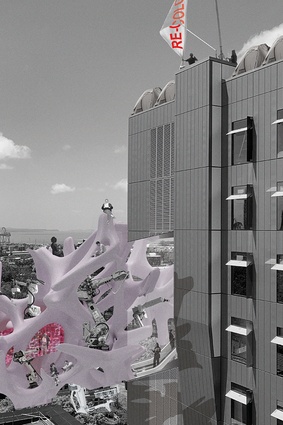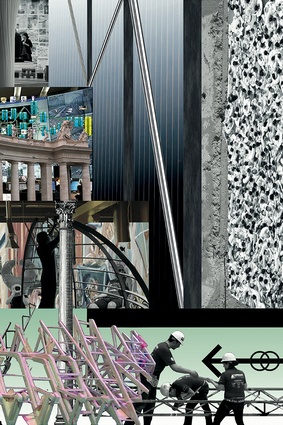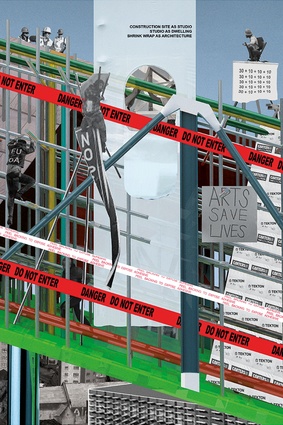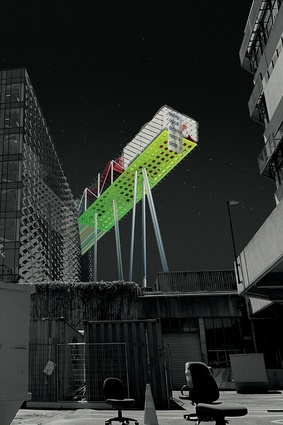NZIA Resene Student Design Awards 2019
In a first for the programme, two students were declared winners of the annual NZIA Resene Student Design Awards at the end of last year. Here, Abdallah Alayan and Jeremy Priest present their award-winning projects.
Faith in Fiordland
An architectural prospection on spirituality and tourism by Abdallah Alayan
In an increasingly secular society, the spirit has been demoted as an architectural priority. This series of architectural interventions seeks to address the growing non-religious demographic within Aotearoa through spaces which encourage spiritual engagement. Exploring the abilities of architecture in generating poetry and heightening spirituality within the landscape, the series aims to develop the New Zealand vernacular further and unlock the potential of Fiordland’s built fabric.
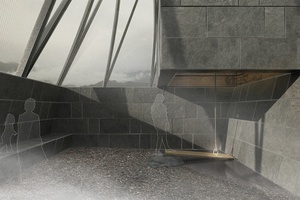
The interventions speak to the existing journey from Lake Te Anau to Milford Sound, which is currently connected by the Te Anau–Milford Highway. Accessible on foot from various nodes along the highway, the architectural series is accompanied by a proposal for a new track, which connects all four interventions and ushers explorers from Te Anau towards the Milford and Routeburn Tracks. It generates a natural, architectural and, ideally, spiritual pilgrimage.
Unravelling itself from behind dense bushland alongside Lake Te Anau’s Patience Bay, the Melodic Spire symbolises the beginning of this journey. Inspired by the strong tie between sound and spirituality, an explorer’s experience of the spire is a sonic one. While framing natural sounds inherent to the site, the external woven brass mesh sleeve of the spire shrouds a melodramatic instrument. Descending downwards into the passages that surround the spire, explorers enter the spire’s base and are enticed by an oversized brass pedal. When struck, the pedal activates a network of thousands of brass chimes, inducing a captivating kinetic and sonic experience for explorers.

Nestled amongst a birch forest, the second intervention takes inspiration from the concept of purification and the spiritual weight of water. The Cleansing Circuit is a loop which accommodates various modes of ablution while connecting the woodland to the shores of Lake Te Anau. The loop encapsulates a section of forest within a central impluvium, which forms the private view for two saunas, providing poetic experiences from the habitual and universal practice of sanitation.
The third intervention aims to accommodate spiritual practice in groups. The spatial condition of the interdenominational Congregation Chamber is defined by an elongated stair, which leans across the Hollyford River. Towards the west, the terraces function as a space for standing congregations, suitable for the likes of Jewish and Muslim prayer rituals as well as for yoga. Conversely, towards the east, the terraces form benches, which face an altar and allow for Christian and Pagan worship, secular performance or seating for meaningful pause.

The final intervention takes inspiration from the idea of introspective meditation. The Contemplative Booth diverts an existing boardwalk along the Key Summit Track upwards into an interstitial space. The booth is accessed by two bridges and explorers can raise the bridges by pulley and occupy the space, which is detailed to encourage the burning of incense for a sensory pensive experience.
By extracting and spatially abstracting common practices from a variety of faiths, the inclusivity of all four interventions articulates a sense of unity between the religious and the non-religious through a shared connection to the spiritual weight of nature; it allows explorers to embrace an enhanced sense of place and purpose as they rest and rejuvenate during their Fiordland experiences.
– Abdallah Alayan
Protest Academia
A response to the corporatised university by Jeremy Priest

Born out of the closure of the University of Auckland’s Architecture and Planning Library, Protest Academia is a self-referential investigation into the ways occupational protest may be utilised to defend and facilitate creative practice within future academic climates. The project suggests that, as it was with the library, the university no longer sees the importance of the creative studio and, in colonising it, displaces the architecture faculty.

The project begins in satirical speculation, with an addition to the city campus’ newest engineering building. A 180-metre-long bar, holding a series of ‘flexible’-though-ineffectual learning environments, extends from the Symonds Street–Grafton Road intersection to jut out over the building’s motorway-facing façade. The bar acts as a billboard for enrolment in the School of Engineering. Protest Academia is an occupation of that phallic proposition, mid-way through its construction, by the displaced faculty of architecture. The structure’s superfluous spaces are re-appropriated, replacing flexibility with intense specificity.
The first segment of the occupied bar, Corporate Camouflage, digs into Symonds Street, blending into the now-colonised academic landscape with a multilayered façade of mirrored ambiguity. Inside, a lecture theatre extracts maximum revenue with minimum effort, servicing an unlimited audience with recorded content facilitating online learning. A central escalator acknowledges the theatre’s importance but understands that there are more parts involved in a rich, heterogeneous education.
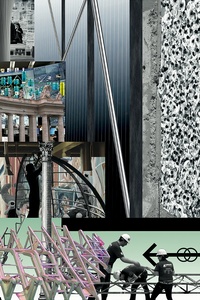
Secondly, The Sawtooth houses staff, outputs research and siphons funding from the School of Engineering above to support the Creative Arts. Formally, The Sawtooth discusses the university as a factory, a business and an employer, referencing cuts to studio teaching hours and papers per semester alongside increased cohort sizes. A billboard faces Symonds Street, casting messages, satire and critique of the university back down upon its most traffic-heavy crossing.
The central segment, The STEM Cell, acts as a bridge, both physically and metaphorically. This reincarnated athenaeum amalgamates the Architecture and Planning Library and the architecture school’s Digital Research Hub. The latter cloaks and provides proxy funding to the former. The rectilinear library hiding in the centre is understated; unlike the Digital Research Hub, it does not produce a quantifiable output though its existence and the studio’s proximity to it are crucial.
The fourth segment, The Mountain, critiques hierarchy. Escalators work to develop hyper-interaction between studio occupants – fusing the bar’s terraces into a single plane, devoid of storeys. Each terrace hosts specific academic curiosities, facilitating collaboration based on mutual curiosities, not stage of degree. A border wall between the bar and the space it intersects discusses defence of pedagogy, segregation and insularity. With the wall’s inevitable destruction comes an environment of beneficial, collaborative practice.
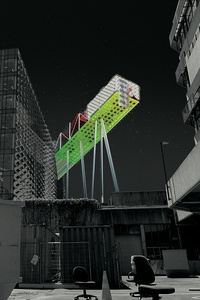
Lastly, The Construction Site is the occupation’s most unregulated area. Furthest from Symonds Street, bureaucracy and red tape, it allows ideas to become inhabitable spaces and challenge the university. Scaffolding and building wrap become spatial tectonics. This is now the image projected out towards the motorway: a self-contained, self-regulating chaos, holding immense creative potential. Glowing all night, it is a beacon: always on, always visible, illustrating the inability to surrender from the occupation. If we abandon the bar or our current studios, they will be lost to the bottomless appetite of the corporate university.
The project is as much a celebration of the Auckland school as it is an interrogation of its existence within a hypothetical, yet increasingly likely, future environment. Protest Academia demonstrates the importance of the physical realm in an architectural education, the power that protest and occupation have to defend and facilitate ideology and pedagogy, and the ways in which the architecture faculty can lead the university forward.
– Jeremy Priest

